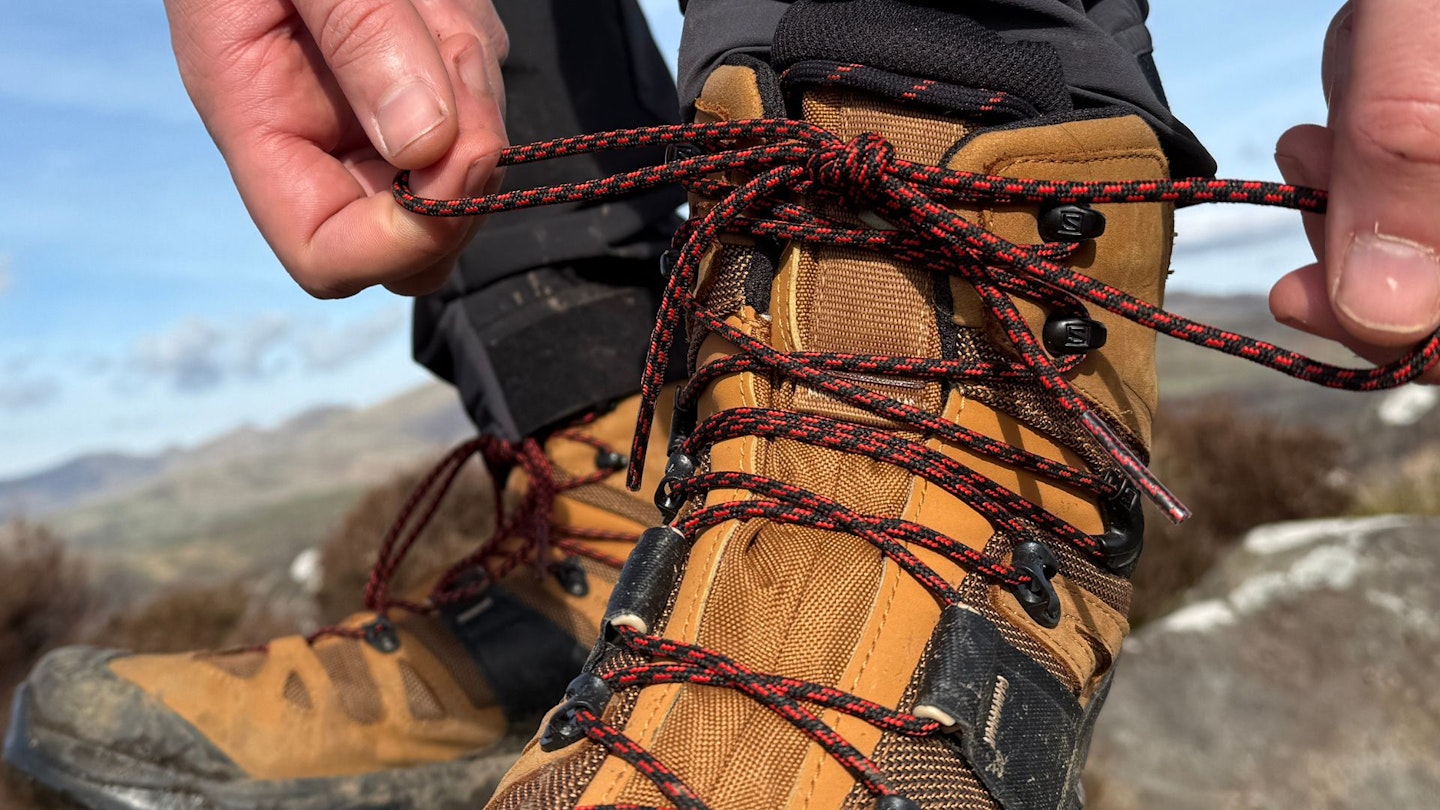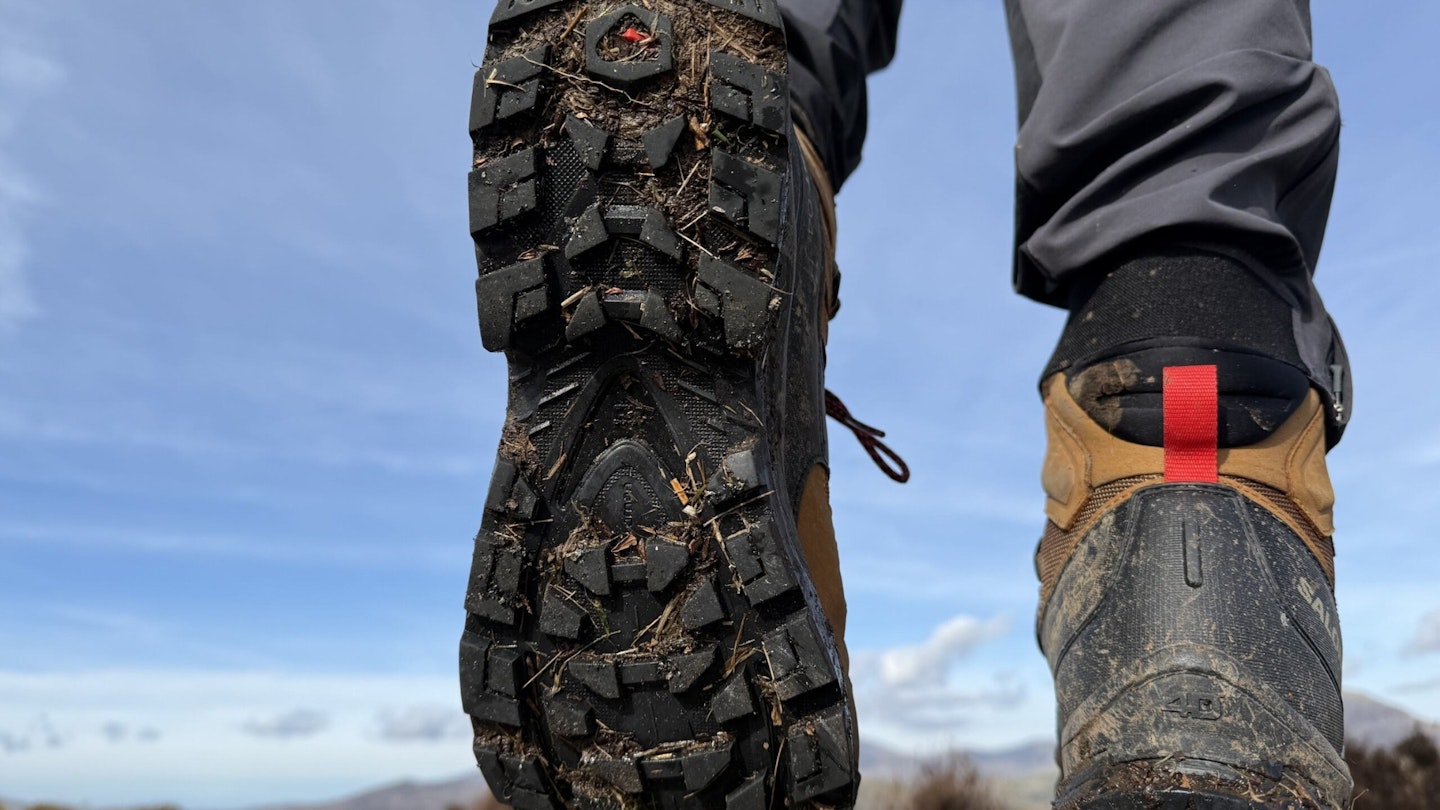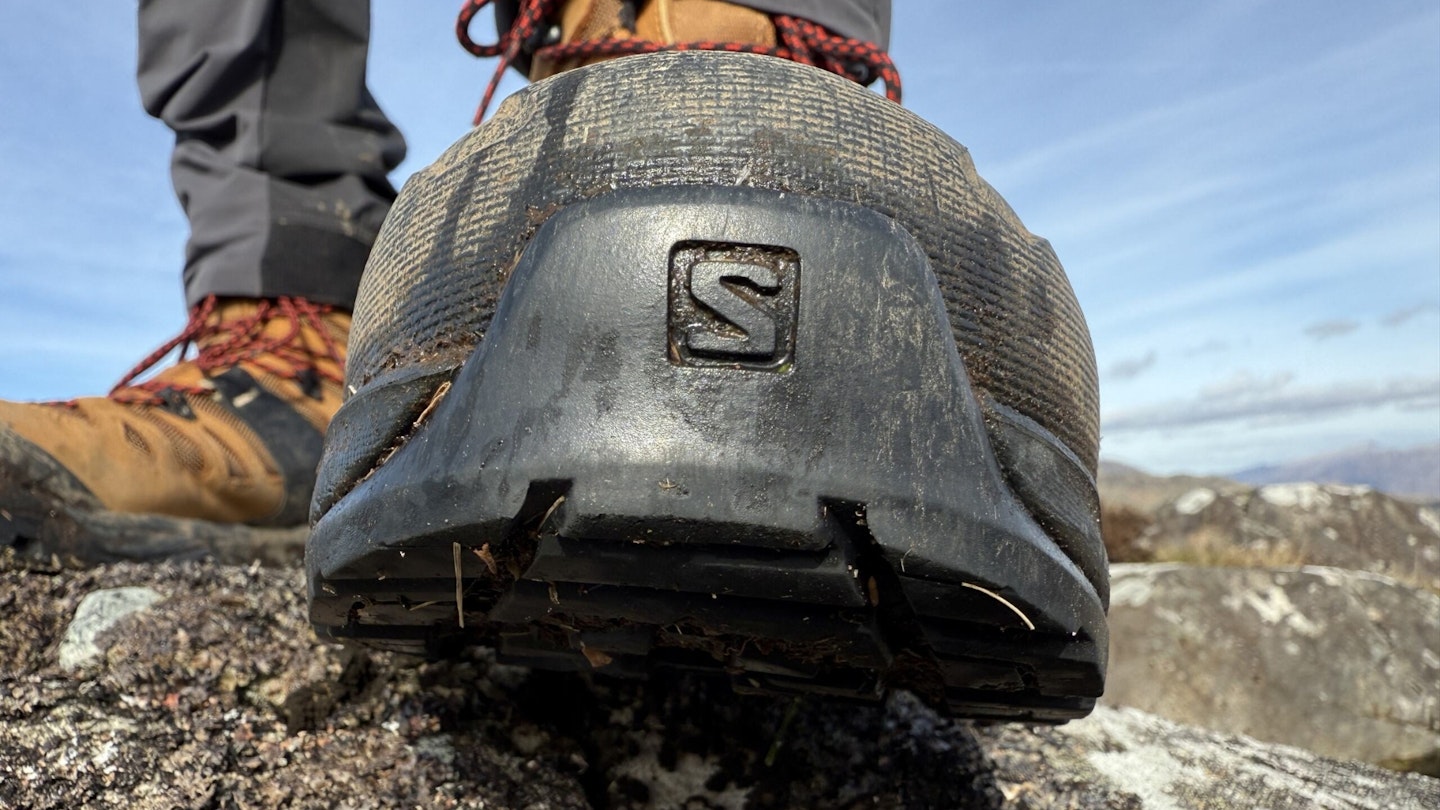As the fourth in its generation, the Salomon Quest 4 GTX is a popular walking boot which aims to build on the strengths of its predecessors, adding some clever new tech designed to increase stability and durability, whilst saving overall weight.
Salomon says it's ‘designed for long expeditions and tough conditions’, prioritising underfoot traction and all-round support while keeping your stride fluid for ‘a stable yet smooth ride on any terrain’.
We’d agree with that. For us, the Salomon Quest 4 GTX works best on multi-day, long-distance backpacking trails, especially if you’re carrying a big, heavy hiking backpack. Fit is always subjective when it comes to footwear, but on test it kept our feet happy even after multiple miles on the mixed terrain of Snowdonia’s mountains.
Find the women's version here.
Pros
- Supportive
- Protective
- Reliable traction
Cons
- Fairly warm
- Too flexible for technical mountain terrain
| RRP: | £200/$230 |
| Weight (per boot): | 655g/1lb 7oz (men’s EU 42/UK 9), 535g/1lb 3oz(women’s EU 39/UK 6) |
| Construction: | Nubuck leather and textile |
| Waterproofing: | Gore-Tex liner |
| Outsole: | Contagrip All Terrain |
| Sizes: | UK 6.5-13.5 (men’s); UK 3.5-9.5 (women’s) |
You can dial in a fine-tuned fit courtesy of an excellent lacing system, while the moulded OrthoLite insole and forgiving upper ensure a snug yet protective feel. The Contagrip outsole’s aggressive lug pattern provides good traction, a Gore-Tex liner keeps your feet dry, and the 4D advanced chassis, wide forefoot and very high ankle cuff ensure top-notch stability and support.
Downsides? Though we didn’t experience any issues, some users have questioned the Quest 4’s long-term durability and waterproofing qualities. With multiple leather/textile panels and a Gore-Tex liner there’s no denying that they take a long time to dry out if they do get wet.
They can feel heavy on the foot when sodden too. Then there’s the fact that stiffer boots will be better suited to technical, rocky terrain, while lighter pairs may prove comfier for fast-paced miles on long-distance trails.
Upper

The uppers of the boot are constructed from a mix of nubuck leather and textile panels, treated with a durable water-repellent finish and backed with a Gore-Tex Performance Comfort liner. All these elements are PFC-free.
This is a high-cut boot, offering plenty of ankle support. The tongue and Achilles padding are soft and supple, though the rest of the ankle collar is relatively firm, focusing on protection and stability over plush cushioning.
As well as a chunky rubber toecap, there’s a raised heel counter for stability and protection. A band also wraps the heel and connects it to the midfoot via flexible ‘wings’ on both sides. Salomon calls this system ‘Active Support’, which is designed to brace the midfoot, adding some adaptability to the boot’s overall shape and volume.
Lacing hardware extends down the vamp towards the toe, consisting of nubuck and webbing loops combined with riveted metal loops, upper lace hooks and a very secure locking runner at the base of the ankle. This makes it easy to adjust the fit separately across the top of the foot and around the ankle.

In addition, it ensures a good flood height whilst preventing debris from entering the shoe and keeps the tongue nicely centred too. It’s an excellent design.
The only downside is that those locking lace hooks are positioned just in front of each ankle bone, and when lacing the boot tightly I was conscious of some pressure in this area. It didn’t cause too much discomfort but could be problematic for some wearers, depending on how bony your ankles are.
I have a narrow to medium width foot shape overall, but found I could pull the boot in nice and tight with no bagginess in the midfoot area. This was partly down to the flexibility of the gusseted tongue, which is sewn up to the second set of lace hooks but gives a surprising amount of volume adjustment.
Midsole
Unlike most heavy-duty hiking or backpacking boots, which tend to use firmer PU cushioning in the midsole, the Quest 4 features EnergyCell foam rubber, which is an EVA compound. This means the boot offers better shock absorption and feels more forgiving underfoot even after multiple miles.
The downside of EVA compared to PU is that it's less resistant to long-term compression, which is a consideration in terms of lifetime durability.

A two-piece Ortholite footbed sits inside the boot. It’s a pretty simple affair, and though it’s a small step up from the flimsy bits of foam you get with most boots, you may still want to swap it out for an aftermarket insole.
On the foot the boot delivers a solid platform with plenty of lateral stability, reducing torsional twisting that can stress or fatigue the foot. The heel and midfoot are noticeably more structured than many trainer-style hiking boots, though there is still plenty of flex in the forefoot as well as a slight rocker profile to ensure a natural and comfortable walking action.
We reckon this is down to the plastic insert embedded in the midsole, which Salomon calls a ‘4D chassis’. According to the brand, this chassis enhances stability on uneven terrain whilst also offering extra support around the heel, reducing fatigue – especially with a heavy pack.
Outsole
The outsole, like all Salomon footwear, is made from the brand’s own Contagrip rubber, specifically the ‘all terrain’ compound. It’s a fairly classic hiking boot pattern, with blocky tread around the edges of the sole for good contact grip, plus angled lugs in the centre for uphill and downhill traction.

The heel breast isn’t as sharply undercut as some boots though, which means you don’t get so much bite on soft slopes, particularly when descending. Still, the rubber seems to offer a good balance between outright tackiness and durability, offering good grip across a range of surfaces yet also wearing decently well.
Performance and comfort
The Quest 4 fits broadly true to size. Thanks to its fairly wide toebox and range of adjustment around the midfoot, it should accommodate a range of foot shapes and volumes. Once the boot is properly laced, your feet feel securely locked in and very well protected.
Expect a bit of break-in time, especially if you’re not used to wearing a high-ankle boot, as the nubuck uppers are quite stiff when new. And since the padding around the ankle collar isn’t the plushest, it seems to take a while to conform to your ankle bones.
Still, once you’ve put a few miles in, this is a comfortable boot. It’s also pretty capable, with a solid yet flexible feel that works well for classic trekking or backpacking with a heavier pack, when the stable platform underfoot and secure ankle support are undoubted benefits.

It’s worth noting that it’s quite a warm boot, thanks to that combination of nubuck leather uppers, thick textile panels and a Gore-Tex liner. There are undoubtedly cooler and more breathable options out there, so if you suffer from hot, sweaty feet, the Quest 4 probably isn’t going to work very well for you. On the other hand, this makes it a good boot for typical chilly and damp UK hillwalking conditions.
It performs decently well in upland environments too, though in our opinion a dedicated mountain boot is a better choice for sustained ridge walks and scrambles. Nor is this boot quite stiff enough to take a crampon in winter, which limits its use to conditions below the snowline. However, for three-season hiking and backpacking, it’s a sturdy and reliable companion.
On the scales, it weighs in at 655g per boot (men’s UK 9) or 535g in a women’s UK 6. That’s heavier than most three-season rivals, though a bit lighter than some other similarly chunky backpacking-focused high-cut boots like the KEEN Karraig, Columbia Geoterra Trek, Berghaus Storm Trek or the new Oboz Bridger Ridge. And it’s still a fair bit lighter than more traditional all-leather boots like the Meindl Bhutan or Lowa Tibet GTX.
Price and competition
We can see why the Quest 4 remains a popular pick, although it’s maybe not as groundbreaking as it was when Salomon first launched it in 2011. Back then, it offered similar protection and stability to many traditional all-leather hillwalking boots, whilst also being lighter and more flexible, with better out-of-the-box comfort. It also undercut a lot of competitors on price.

Four generations later, it’s still decent value – especially as it hasn’t broken the £200 price barrier, unlike a lot of similarly well-established rivals. On the other hand, many hikers and backpackers have now moved on to superlight, super-flexible trainer hikers, with plenty of stack height for maximum underfoot cushioning. The Quest 4 is emphatically not that sort of boot.
In contrast, it has a solid and stable feel, which some will find reassuring. However, it’s still not as capable in the mountains as a modern alpine boot. If that’s what you’re after, try something like the La Sportiva TX5 or Aequilibrium ST, or perhaps the Salewa Alp Trainer or Mountain Trainer.
The Salomon Quest 4 is really aimed at distance trekking – i.e. backpackers and wild campers who lug heavier loads in the hills for multiple days on end and need a stable, supportive and protective yet also comfortable boot.
Sustainability
As a brand, Salomon is working towards some key sustainability targets to be implemented by 2030. By this time, it's aiming for 100% of its key products to be eco-designed or circular, with a science-based target to deliver a 30% absolute reduction in its carbon footprint compared to 2019.

The Good On You Directory, which evaluates brands based on the environmental policies in their supply chains, rates Salomon “Good”, but only gives it 3 out of 5 overall due to its limited supply chain transparency.
In product terms, there’s no evidence that the Quest 4 GTX uses any recycled materials. Uppers are made from nubuck leather and textile, but no certifications are cited in terms of responsible sourcing.
However, the durable water repellent finish is PFC-free, while the Gore-Tex lining is also PFCec-free (Gore’s terminology for ‘PFCs of environmental concern’).
Verdict
The Salomon Quest 4 is a supportive backpacking boot with a secure yet comfortable fit that offers great foot protection, ideal for covering big miles and carrying heavy loads.
Shop this product
About the author

Matt Jones is a freelance journalist based in the heart of Snowdonia National Park, he’s a vastly experienced gear tester and self-confessed outdoor kit geek. Matt’s been one of our main gear testers for the last couple of years and is the first person we call with any complicated kit queries that need in-depth and forensic analysis.


